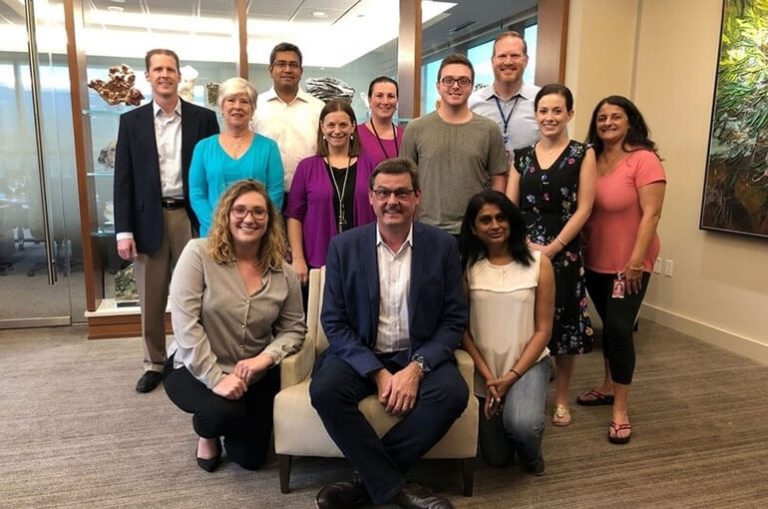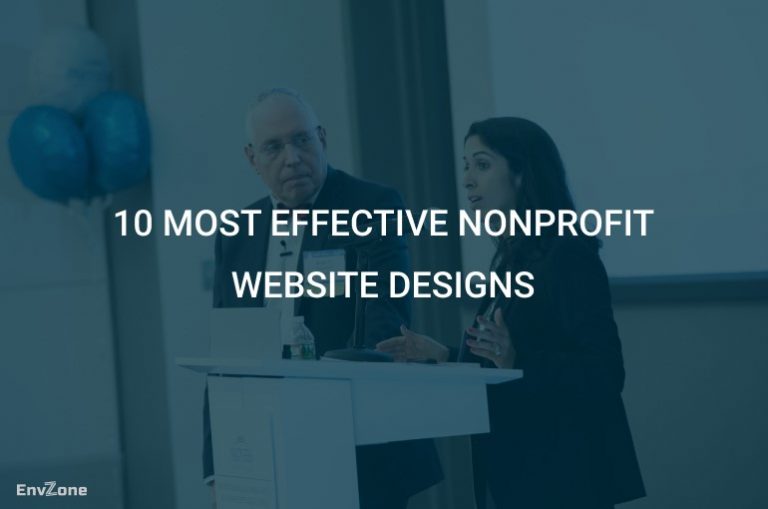Technology Infrastructure for Nonprofits: Key Roles & Remarkable Examples
Do nonprofit organizations take the digital world and technology infrastructure seriously? As reported by NetChange’s long-running survey of technology use by nonprofits, only 11% view their organizations’ approaches to digital as highly effective – in fact, several nonprofit bodies are “leaving significant impacts on the table”!
Generally, the nonprofit sector is not known for being particularly innovative or open to change. Since these organizations are too focused on their mission – typically, feeding and educating people or helping the disabled, they are not investing enough time thinking about how to improve their margins or bringing in more business the way that a startup or any for-profit company would.
Leveraging technological advancements in the sophisticated ways we’re typically thinking about is just new to a whole lot of individuals – especially those who are older and less technologically savvy, many of whom are leading nonprofits. Furthermore, the community-based and nonprofit sector tends to run on tight budgets, hence the cost of state-of-the-art technology can seem to be a little bit prohibitive for them to incorporate into their operating infrastructure.
Nevertheless, as a matter of fact, increasing technology uptake within the nonprofit landscape does allow nonprofit organizations and social workers to provide more effective services through improved work processes. Indeed, smart adoption of technological transformation as well as robust establishment of technology infrastructure for nonprofits can spawn innovation, improvements in efficacy, and better delivery on mission – more than justifying the cost and the challenges of organizational change.
Are you still doubtful about this? Then, let’s go through the key roles of technology adoption in the nonprofit field as well as some outstanding examples of successful nonprofits employing technology.
Technology Potentials: Why Should Technology Adoption Be an Area of Focus for Nonprofit Management?
It is completely fair to state that technology fosters innovation and growth of such a philanthropic nonprofit space! Technological innovations – especially in the realm of mobile, data, and cloud-based solutions – are well expected to offer nonprofit bodies golden opportunities to reduce the time and cost it takes to effectively deliver services, fundraise, and engage stakeholders. Let’s see how it works!
#1. Optimizing Service Delivery

In practice, nearly all nonprofits utilize information technologies to provide services to their clients – some current information technologies that these organizations employ for program and service delivery include websites, e-mail systems, and databases. Nonetheless, prevailing mobile technologies as well as software systems, which would allow social workers to facilitate communications with clients and access agency information off-site, are just adopted by few nonprofits.
According to Columbia Social Work Review, Volume IV, by Brianna Boles, not-a-large-enough percentage of non-profit institutions use mobile tech such as smartphones, personal device assistants (PDAs), and mobile applications to track clients – and even if they do, only 40% of those users collect data while in the field with clients. Also, even a smaller number of nonprofits did take advantage of available tracking software systems to record outcome data for client and volunteer management, which is undoubtedly serious mismanagement.
Another noteworthy concern is that whereas nonprofits integrate basic technologies into their program areas to be of service, the degree to which updated technologies are incorporated should be re-evaluated for improvement.
Practically, an adequate combination of data and mobile solutions will probably allow social workers to reach more users and deliver services more quickly and effectively. For instance, to address the challenges that social workers come up against when traveling in the field, they can sync their portable devices to office databases. By this way, data could be accessible off-site through server software, which would save social workers time from having to go back to their sites and reduce translating paperwork and notes into agency-based computers.
Additionally, to better satisfy funders’ requirements, which mainly depend on results-driven service delivery to inform decision making, a secure database with outcome tracking software will allow nonprofits to measure inputs – the expected goal(s) or pre-intervention as well as outputs – the actual goal or post-intervention. On those grounds, nonprofit organization executives can have an easier time of reporting client outcomes to funders.
Undeniably, leveraging data to inform programmatic and service delivery practices is more than essential to deliver scalable services to clients. However, since numerous nonprofits do not clearly define a plan for measuring the success of a program, they also fail to keep track of data about outcomes of clients and stakeholders. This indicates the fact that the absence of a well-established plan to assess program successes is a potential reason for nonprofits’ failure to adopt technologies.
#2. Fostering Fundraising
As a rule, to drive fundraising efforts, the majority of nonprofit organizations rely on foundation proposals, special events, major gifts or direct responses via mail, board support, and online giving. Also, more nonprofits target individual contributions – given the fact that although individuals’ giving decreased in 2018, it still stood at staggeringly 68% of total giving (an estimated $292.09 billion, adjusted for inflation), according to Giving USA.
Despite a promisingly growing market, there are not a large number of nonprofits using Facebook advertising for fundraising and individual giving purposes. Whilst more and more nonprofit institutions have tapped into social media sites over recent years, they are yet to maximize or even make use of Facebook’s fundraising functions.
In fact, mobile technologies, particularly applications and text messaging functions, are a missed fundraising opportunity for nonprofit organizations. To illustrate, text-to-give campaigns have become increasingly popular channels for donors to contribute to causes.
To be more specific, when it comes to text-to-give campaigns, the organization can set up a short code, campaign keyword and donation amount – limited to $5, $10, $15, $20, $25, $30, $40 or $50 – sometimes, they can also set up recurring donation options. Should a supporter or a donor feel inspired, they can text the campaign keyword to the shortcode. The pre-determined donation amount is then billed to the supporter’s cell phone bill by their carrier. Finally, the carrier processes the donations and transfers the total donations to the organization.
If the text messaging feature of mobile phone, itself, is not preferred by all, smartphone applications emerge as a better way for mobile users to donate for the good causes. To take an example, there is an app so-called “iKettle” from Salvation Army, which allows users to set up their own fundraising campaigns. When adopting this or other apps alike to solicit donations, non-profit organizations are provided with immediate receipt of the donation, and donors can also donate any amount, rather than a limited donation of $5 or $10 dollars through text messaging.
After all, it’s proven that mobile capacities do offer nonprofits a super-powerful way to generate donations while engaging with stakeholders.
#3. Expanding Outreach & Engaging Stakeholders
Over the past few years, a plethora of nonprofits has leveraged social media such as Facebook, Twitter or Linkedin to generate awareness about their cause-driven work as well as its impact in the community. Some seem to understand the usefulness of these social sites in promoting engagement and outreach to more constituents – just by 2011, up to 80% of nonprofits believed Facebook provided stakeholders with more information and generated more awareness.
Nonetheless, whereas many nonprofit groups actively use Facebook to engage donors, fewer number of them employ mobile phones’ functions for greater outreach and awareness, which can include the development of mobile-friendly websites and smartphone applications.
If you, as a non-profit head or executive, plan to bring these tactics into play, it’s a “must” to first assess whether mobile technology fits into their organizational objectives prior to implementation. Should you figure out that your stakeholders regularly use mobile phones to donate and can be effectively engaged through that method, then it’s high time that you started off “benefiting” from integrating mobile technology into practice and hugely investing in it.
What’s more, a potential strategy for a nonprofit will be to build out a website – that can be accessed on mobile devices (of course) and incorporate handy techniques such as highlighting key messages, keeping content organized and interactive, and using videos, larger pictures, and text with less content. In addition to delivering effective services to clients and steppingup fundraising efforts, integrating new technologies, particularly mobile technology, into operations will allow nonprofits to build a stronger community base and foster better interactions with donors.
Outstanding Examples: How Do Nonprofits Leverage Technology Adoption to Accomplish Their Philanthropic Causes?
#1. American Water Works Association

For those not in the know, the American Water Works Association (AWWA) is an international, nonprofit, scientific and educational society dedicated to providing total water solutions assuring the effective management of water. Founded in 1881, the Association stands as the largest organization of water supply professionals in the world.
Speaking of their scale, AWWA’s membership does include up to 4,300 utilities that supply approximately 80 percent of the nation’s drinking water and treat almost half of the nation’s wastewater. Also, their over 51,000 total members represent the full spectrum of the water community: ranging from public water and wastewater systems, environmental advocates, scientists, academicians to those who hold a genuine interest in water – their most crucial resource. Besides, the non-profit organization takes great pride in helping establish two preeminent organizations dedicated to safe water, the Water Research Foundation and Water For People with a view to advancing public health, safety, the economy, and also the environment!
But from the very first step, the biggest questions arose: How can they balance public health with reasonable precaution? How do the manufacturers bring technologies and innovations to water professionals who are resistant to be the first ones to try something new, to be “guinea pig”? Those concerns were on the minds of utility leaders who were often prevented from employing new technology because of regulations, the sector’s perceived aversion to risk, and many other factors.
Finally, a panel of heavy hitters ended up having a formal talk about handling barriers to innovation and new technology. “The family of five” turned out to be this session’s main focus to speed up acceptance of new technology in the water sector – the infrastructure of “five” do include utilities, manufacturers/service providers, consultants, regulators, and academics, who all have a role in delivering safe water to the public.
“The goal will be to come away with action items,” said Randy Moore, the session’s moderator and vice president of market development for Pure Technologies, a service provider to the water and wastewater industries. “We will have concrete examples of things we can do as a family of five working together to promote innovation and new technologies in the water sector.”
#2. Water Environment Federation

Similar to AWWA, the Water Environment Federation (WEF) is a not-for-profit technical and educational organization of over 35,000 individual members and 75 affiliated Member Associations representing water quality professionals around the world. Since 1928, WEF teams, together with its members, have proudly protected public health, served their local communities and supported clean water worldwide. Amongst the global water sector leaders, their mission is to connect water professionals, enrich the expertise of these professionals, heighten the awareness of the impact and value of water as well as provide a platform not only leveraging but also fostering technological innovation over the water sector.
When it comes to technology adoption by the Water Environment Federation, it will be a serious mistake to not to mention the Leaders Innovation Forum for Technology (LIFT) – a multi-pronged initiative undertaken by The Water Research Foundation and WEF to help bring new water technology to the field quickly and efficiently. Together, they gather up the best scientific minds and industry specialists to accelerate the adoption of innovative technologies and then form a sound technology infrastructure with these core values:
- Technology Evaluations: Facility and industry end-users share the cost of conducting demonstrations to facilitate the adoption of new technologies.
- People and Policy: Bench-marking how individual utilities accomplish the identification of resources and policies needed to implement effective research and development.
- Communication: In-depth training, education as well as outreach designed to promote innovation.
- Utility Peer Network: There exists a dynamic mechanism for technology and R&D managers to share experiences and collaborate on innovation.
#3. TechSoup Global

Founded in 1987 and formerly known as CompuMentor, TechSoup Global is truly a nonprofit organization established for nonprofit organizations. By developing an infrastructure for nonprofits to stay informed on how to employ, TechSoup Global is dedicated to building a dynamic bridge that enables civil society organizations and social change agents around the world to gain effective access to the resources they need to design and implement technological solutions for a more equitable planet.
Through their online platforms and offline campaigns such as Web sites, events, and community-building initiatives, NGO members in Africa, the Americas, Asia Pacific, Europe, and the Middle East share ideas on how to solve social issues and become agents of global change. Then, they will be able to connect their respective communities to the best local and global technological resources to assist with the social issues they are focused on addressing, which allows these non-profit bodies to operate at their full potential and optimize their philanthropic impact.
With a view to connecting technical mentors with community activists in the San Francisco Bay Area, TechSoup’s renowned collaboration approach and award-winning, innovative social enterprise business model has enabled a cooperative platform at scale. As a “connector across sectors,” TechSoup Global is backed by more than 90 leading tech companies – including Microsoft, Adobe, Cisco, and Intuit– and they network with a large number of social enterprises, companies, foundations, and technological activists.
More than 100 corporate donors and providers of software, hardware, and services have chosen the TechSoup platform and model to create and grow impactful in-kind donation programs wrapped in nonprofit education and support. More than 1.2 million nonprofits in 236 countries and territories have benefited from TechSoup and recognize TechSoup as their unique resource partner.
Indeed, TechSoup’s cooperative models, coupled with its international network of nonprofit partners and its wise adoption of technology and data to drive sector value, have given it a unique leadership position. TechSoup continuously innovates programs and experiments with the community to find ways to meet new needs and create value. Together with its partners, TechSoup has collectively grown the tech resources devoted to expanding the capacity of the global social sector. They have increased this capacity more than 10- to 30-fold since 2001, dramatically strengthening programs and impact for beneficiaries in the process.
Up to now, the TechSoup Global “One-of-a-Kind Civil Society” Network consists of 70 nonprofit capacity-building organizations around the world sharing a common vision and mission — to strengthen the local communities and nonprofits they reach with technology, know-how, and access to peers, experts, volunteers, grants, and other resources – what they need to take their work to the next level. In fact, its nonprofit, social enterprise activities operate like an e-commerce distribution service with global reach – these activities are connected by a common data-driven platform, shared business process, and mutual values, localized to deepen impacts. Thus, there seems to be no doubt that the interconnectedness and readiness of this network to act at scale and local relevance is unparalleled!
#4. TED – Ideas Worth Sharing

There goes without saying that TED is a super-familiar name within the philanthropic scene. As a nonprofit devoted to spreading ideas (usually in the form of short yet powerful talks), TED began its meaningful journey in 1984 as a conference where Technology, Entertainment, and Design converged, and today covers almost all topics – from science to business to global issues – in more than 100 languages.
With a mission to spread “worth-sharing” ideas, TED is considered to be a global community, welcoming people from every discipline and culture who seek a deeper understanding of the world. On TED.com, they have established a clearinghouse of free knowledge from the world’s most inspired, brilliant thinkers and visionaries – as well as a community of curious souls to engage with ideas and each other, around the world and all year long.
TED teams believe passionately in the power of ideas to change attitudes, lives and, ultimately, the world. They have discovered that no knowledge is isolated and that everyone is part of an interconnected whole. And its online platform serves as a global connecting hub to engage, relate, and take action around game-changing ideas. Currently, TED teams have two annual conferences, TED Conference and TED Global, along with an award-winning TED Talks video site, fellowship programs, local TED series, and an online translation project. With innovation at its heart, TED is determined to see the power of ideas change the world.
The Bottom Lines
Within such an ever-evolving technological landscape, nonprofit organizations are granted golden opportunities to benefit from emerging technologies to deliver better service delivery, drive fundraisingefforts or expandoutreach and engaging stakeholders. Whereas many nonprofits only focus on how to employ basis technology to gain social exposure for their causes – simply a means to get found, there are some remarkable organizations that are leveraging the infrastructure of technology itself to advance their philanthropic missions.









